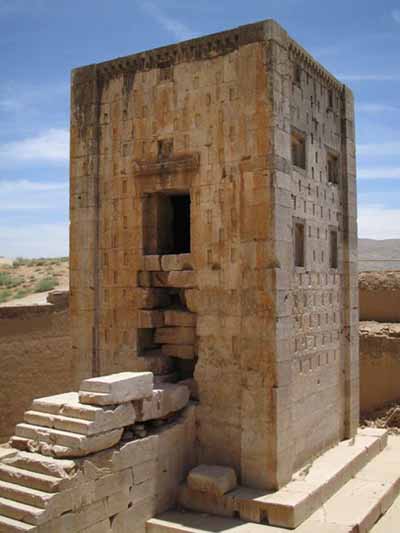

Every architect, brings to his creation, reminders of its central theme. For Zoroaster, Z, it is about The Box, The Cube, Stone vs. Light Energy in the Duality of his Design. The old will always give way to the new, sometimes gradually, but other times suddenly. In the days of ancient Persia, Zoroaster and his followers, some linked as the 3 wise men from the East or the 3 magi (with symbolic references to 'magicians in 3D'), went out on long pilgrimages to preach their gospel, monotheism and duality, good vs. evil. But Z left other clues in the game to remind the souls that we exist 'in the box' of time. The 3 Wise Men from the East (beginnings) set the stage for the next major insert of experience, as the old programs faded into history... but the grid maintained its geometric design.
Ka'ba-i Zartosht, The "Cube of Zoroaster" Wikipedia
The structure, which is a copy of a sister building at Pasargadae, was built either by Darius I (r. 521-486 BCE) when he moved to Persepolis, or by Artaxerxes II (r. 404-358 BCE) or Artaxerxes III (r. 358-338 BCE). In Frye's opinion the intention was the same as that of its sister building, that is, to build a safety box for the paraphernalia of rule in the vicinity of Persepolis as had been done at Pasargadae. From a reference to fire altars in a Sassanid-era inscription on the building it has been inferred that the structure was once a fire altar, or perhaps as an eternal-flame memorial to the emperors whose tombs are located a few meters away. This is however highly unlikely since the lack of cross-ventilation would have soon choked the flame.
Railroad jeopardizing Zoroaster's Kaba -- Iran News, December 4, 2006
Experts say that Zoroaster's Kaba at the Achaemenid site of Naqsh-e Rustam in Fars Province will collapse in less than ten years if the railroad currently under construction near the monuments becomes operational, MNA reported. The powerful jolts caused by trains will devastate the unique Achaemenid monument an expert of the Parseh and Pasargadae Research Foundation, told the Persian service of CHN. A five-meter high embankment spoiling the landscape of Naqsh-e Rustam has been made for the railway track about 350 meters from the monument. In addition, the rumbling of the trains will damage the monument in the future. The embankments for the railway track have been completed from Shiraz to Hajiabad village and from Isfahan to Marvdasht, although the Cultural Heritage and Tourism Organization never approved any map for the construction of the railroad. In addition, experts believe that the construction of the railroad near the monuments of Naqsh-e Rustam in Fars Province will cause Persepolis to be added to the UNESCO List of World Heritage in Danger.
What was the Zoroaster's Kaba? There are various theories as to its original purpose. Some experts believe that the monument was the home of a complete copy of the Avesta which had been written on 12,000 leather parchments. Some Orientalists also believe that ZoroasterÕs Kaba was a place where the ZoroastriansÕ sacred fire was kept burning eternally. A number of other researchers say that the monument is the tomb of Smerdis, the son of Cyrus the Great, who was murdered by his brother Cambyses (king of Persia 529Š522 BC). Some archaeologists also believe that it was used as an ancient government archive.
In 2005, Iranian archaeologist Reza Moradi Ghiasabadi rejected this theory and described the monument as the world's most unique calendrical and astronomical building. "At the end of Shahrivar (the sixth month of the Iranian calendar, August 23-September 22) we can determine exactly the day of the month by the light shed by the sun on ZoroasterÕs Kaba. It has been used for daily needs, determining the time of cultivating crops, and collecting taxes," he explained. Zoroaster's Kaba bears a Sassanid era inscription explaining the historical events during the reign of the Sassanid king Shapur I (241-272 CE). The trilingual inscription, written in the Sassanid and Parthian dialects of Middle Persian and ancient Greek, describes the war between Persia and Rome in which Shapur I defeated Valerian, who was captured in 260 and died in captivity.
ZOROASTRIAN PROPHECY, SAOSHYANT